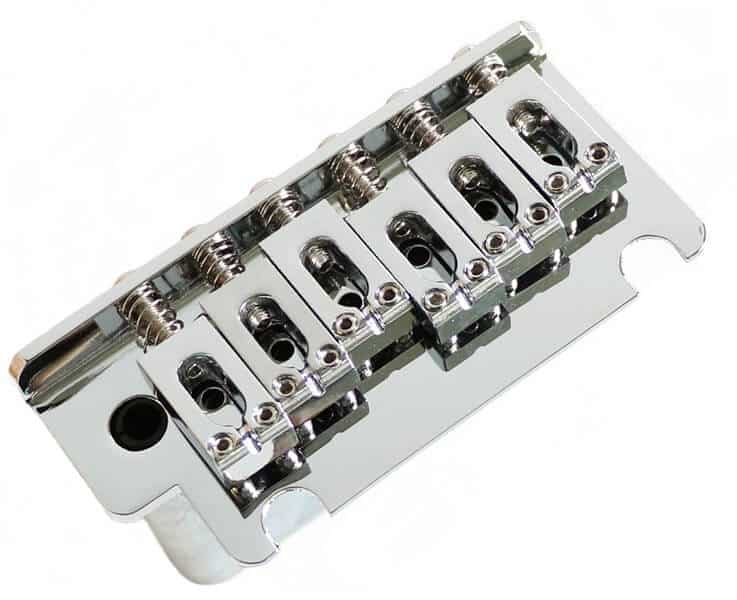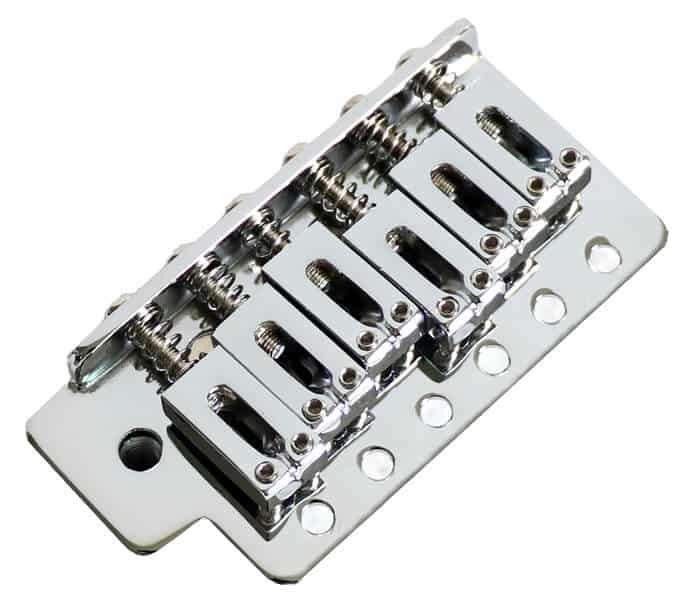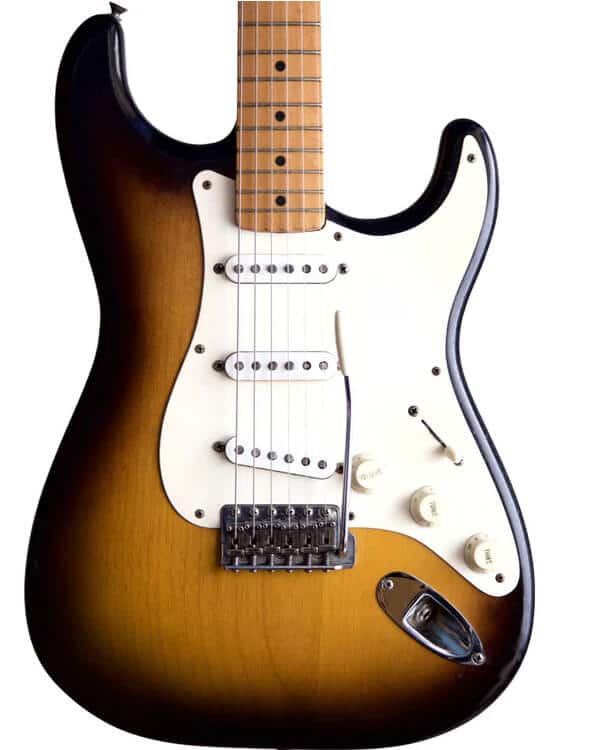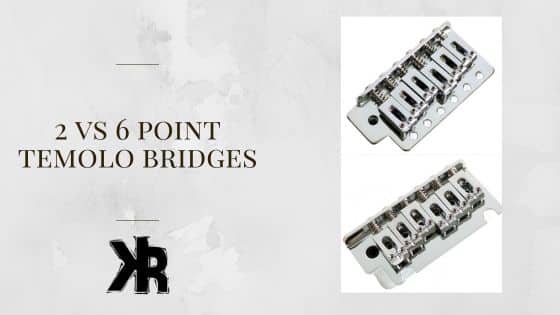Table of Contents
The world of guitars is vast, with every component playing a crucial role in shaping the instrument’s sound and playability. Among these components, tremolo bridges stand out as pivotal hardware pieces that can significantly influence a guitar’s performance.
The debate between 2-point and 6-point tremolo bridges has been a topic of discussion among guitar enthusiasts and professionals alike.
In this Killer Rig article, we’ll explore the nuances of the 2 Vs 6 Point Tremolo Bridges, examining their design, functionality, and impact on a guitar’s tonal quality.
Whether you’re well-versed in guitar mechanics or just starting to explore its complexities, this examination of tremolo bridges promises to be enlightening.
The Short Answer: 2 Vs 6 Point Tremolo Bridges
So, should you care about whether your Strat has a 2-point or a 6-point tremolo bridge? The short answer is: Yes, you should.
The type of tremolo bridge on your Stratocaster significantly influences the instrument’s tonal characteristics and playability.
It directly impacts the sustain of your notes, the simplicity of your setup adjustments, and the variety of pitch modulation effects achievable with the tremolo arm.
If you’re a player who often uses the tremolo arm or if you’re meticulous about your guitar’s tone and sustain, the type of tremolo bridge is a crucial factor to consider
Whether you prefer the vintage vibe of a 6-point bridge or the modern functionality of a 2-point. The choice can greatly enhance your playing experience and help you achieve the sound you’re after.
Understanding Tremolo Bridges
At their core, these bridges allow guitarists to modulate the pitch of the strings, creating a vibrato effect that can add depth, emotion, and flair to a musical piece. Let’s explore some key points:
- Functionality: The primary function of a tremolo bridge is to change the tension of the guitar strings. By using a tremolo arm or “whammy bar,” guitarists can temporarily increase or decrease the string tension, leading to a rise or fall in pitch. This ability to manipulate pitch on the fly allows for expressive bends and vibratos, adding dynamism to solos and riffs.
- Design: Tremolo bridges are anchored to the guitar’s body and have individual saddles for each string. These saddles can be adjusted for height and intonation, ensuring that the guitar remains in tune even after heavy tremolo use. The bridge’s design also plays a role in the guitar’s sustain and resonance.
- Types: While there are various types of tremolo bridges, the 2-point and 6-point variants are among the most discussed. The difference lies in how they are anchored to the guitar body. A 2-point tremolo is pivoted on two posts, allowing for smoother and more stable pitch modulation. In contrast, a 6-point tremolo is anchored by six screws, offering a more vintage feel and response.
- Materials: The materials used in constructing a tremolo bridge can influence the guitar’s tone. Common materials include steel, brass, and zinc, each contributing its tonal characteristics.
By understanding their design and functionality, guitarists can harness their full potential, adding depth and character to their music.
What are the Points on a Stratocaster Tremolo Bridge?
The points on a tremolo bridge refer to the number of places it makes contact with the guitar body.
In a 6-point tremolo, the bridge is screwed into the body at six points, creating a fulcrum that allows the player to detune the strings. This design was the original choice for Fender Stratocaster guitars.
On the other hand, a 2-point tremolo bridge uses two posts screwed into the body. This allows the bridge to pivot against these posts. This design was introduced later to improve tuning stability and reduce friction.
Tremolo Bridge Comparison: 2 Vs 6 Points
The main difference between 2-point and 6-point tremolo bridges is found in their design. Each design affects the guitar’s sound and tuning stability to some degree.
The 2-point tremolo bridge, with its two contact points, offers better tuning and allows for more pitch bending.
On the other hand, the 6-point tremolo bridge, with additional contact locations, is believed to provide better sustain and is often associated with a more vintage sound.
After going over the basics, let’s get into some real technical details on 2-point and 6-point tremolo bridges. Both of these designs have different features and offer the player certain benefits.
2 Point Tremolo Bridges

The 2-point tremolo system was Fender’s solution to improve tuning stability. This design uses two posts, or points, screwed into the body of the guitar. This allows the bridge’s knife edge to pivot against these posts.
The 2-point tremolo’s main strength lies in its tuning stability. It provides some wiggle room for pulling up as well as down on the tremolo bar, allowing you to bend the pitch in either direction.
This design is a nice middle ground between the 6-point and the more complex locking tremolo systems like the Floyd Rose bridge.
Resonance and Support
The 2-point tremolo bridge is often considered to have more resonance. Some players claim that the 2-point style, due to its increased mass, generates a more robust resonance. Its floating design contributes to a specific tonal quality as far as I can tell.
Moreover, the 2-point tremolo bridge provides more support for pitch bending. The design allows for pulling up as well as down on the tremolo bar, giving you more flexibility in altering the pitch.
Ease of Adjustment
The 2-point tremolo bridge is typically viewed as more straightforward to adjust. The two posts that the bridge pivots on can be easily raised or lowered to adjust the action (the height of the strings above the fretboard).
This design also allows for a smoother operation of the tremolo arm, providing more flexibility for pitch bending.
6 Point Tremolo Bridges

The 6-point tremolo involves the bridge being screwed into the body of the guitar at six points. This creates a fulcrum that allows the player to remove tension from the strings.
However, heavy use of the tremolo often led to tuning instability due to the friction created by metal rubbing without lubrication.
Fans of the 6-point tremolo style argue that it provides better sustain since more of the bridge is against the body of the guitar. Moreover, the bent steel saddles on the 6-point bridges are often preferred by purists and fans of vintage instruments.
Resonance and Support
The 6-point tremolo bridge, marked by its six contact points, is commonly associated with increased sustain. Fans of this style claim that it offers longer sustain due to a larger portion of the bridge being in contact with the guitar body.
Consider the acoustic properties of vintage instruments. They often produce sound with enhanced resonance and depth! A quality observed by many in the field. In an analytical comparison, this claim holds merit.
However, when we shift our focus to the sustain of a Stratocaster, regardless of its era, it’s impeccably suited for specific music genres.
The construction of both the vintage and modern variants provides the precise sustain needed for the typical repertoire associated with a Stratocaster.
Ease of Adjustment
Adjusting a 6-point tremolo bridge can be a bit more complex due to the six screws that attach it to the guitar body. Each screw needs to be adjusted individually, which can be a bit time-consuming.
However, many guitarists appreciate the level of control this design offers. With a bit of patience and practice, adjusting a 6-point tremolo bridge can become second nature.

Can You Change Tremolo Bridge Types?
As a guitarist, you might be wondering if it’s possible to switch between 2-point and 6-point tremolo bridges. The answer to this largely depends on your guitar model and your willingness to modify your instrument.
Transitioning from 6-Point to 2-Point Tremolo
If your guitar currently has a 6-point tremolo, and you’re considering a switch to a 2-point system, it’s technically feasible.
However, it’s not a straightforward swap. The 2-point system requires two post holes, which are not compatible with the six screw holes of the 6-point design.
This means you would need to fill the existing holes and drill new ones, which could potentially affect the value and integrity of your guitar. It’s a task best left to professional luthiers.
Transitioning from 2-Point to 6-Point Tremolo
Switching from a 2-point to a 6-point tremolo is an even more complex process. The 6-point system requires six screw holes! This means you would need to drill additional holes into your guitar body.
This could potentially damage your guitar and affect its value. Again, if you’re considering this change, it’s highly recommended to consult with a professional luthier.
Stock Tremolo Bridges
Regarding which type of tremolo bridge is standard, it primarily depends on the specific guitar model. Traditional Stratocaster models often come with a 6-point tremolo bridge, reflecting their vintage heritage.
However, many modern Stratocaster models, come with a 2-point tremolo bridge for better tuning stability.

Should You Really Care About the Kind of Tremolo Bridge on a Strat?
The answer to this question largely depends on your playing style, the genres of music you play, and your personal preferences.
The type of tremolo bridge on your Strat has a substantial impact on the guitar’s tone, ease of playing, and tuning rigidity. For players who frequently employ the tremolo arm for pitch bending effects, the choice of tremolo bridge becomes paramount.
A 2-point tremolo bridge, with its improved tuning stability, might be more suitable for players who use the whammy bar aggressively.
On the other hand, a 6-point tremolo bridge, with its vintage vibe and potentially better sustain, might be the preferred choice for players who play classic rock or blues and value a more traditional sound.
Moreover, the ease of adjustment differs between these two types of bridges. For those adept at guitar maintenance and configuration, this consideration may not hold much weight.
But if you’re new to the game, or perhaps you lean towards simplicity in your setup, this factor could tip the scale in your decision-making.

